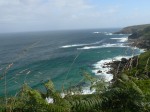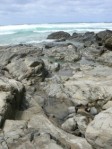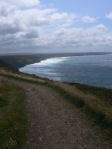July 22
Well, A was right – post holes are two feet deep, so says my iron-age daughter Kate !
This poem came unsolicited or expected, to me today. Perhaps Zennor has granted me the muse which had forsaken me.
HOLIDAY
You –
In that whiplash wind
Balanced on a wall
Of piled Cornish granite
Edging the rough path
Towards Zennor Head.
You –
Sitting, one leg bent casually
Beneath the other –
A grin as wide as the horizon
Beamed toward me –
Hands put together as if
Caught joyfully applauding
This wild place.
You –
In salt spray
Eyes narrowed against sunlight,
Errant strands of hair flying,
Flicking your cheek.
One booted foot
Resting on tangled gorse and heather;
Behind your head
The peacock sea.
Now –
It is necessary to get close,
Focus the image,
Rescue this moment
From oblivion
Now, while purple foxgloves
Are still fluting open,
Welcoming summer bees
Before
The scent of decay.
Today frilly clouds
Are lightly wind-drawn and the sea
Unravels white lace upon pale sand.
The rock pool is translucent:
Water, light, trembling seawrack
And your shadow –
All are gathered there.
 To answer my own question, certainly I found the boundaries of self melt and become absorbed into this wild land and seascape. A lifting of that metaphorical burden for a while. For me, Zennor has this magic power
To answer my own question, certainly I found the boundaries of self melt and become absorbed into this wild land and seascape. A lifting of that metaphorical burden for a while. For me, Zennor has this magic power
 Woke to see the sun throwing shadows on my white door. We decide to go the headland again and take a footpath over the heather, which gives a view of the coast towards St Ives. The sea’s in lively mood, teasing the shore, not roaring in.
Woke to see the sun throwing shadows on my white door. We decide to go the headland again and take a footpath over the heather, which gives a view of the coast towards St Ives. The sea’s in lively mood, teasing the shore, not roaring in.


 A site from which can see two coasts. In the village, we look at the foundation stones of the houses, then speculate and argue:
A site from which can see two coasts. In the village, we look at the foundation stones of the houses, then speculate and argue:
 It’s 5am and a bright chunk of dawn has streaked between my bedroom window frame and the wall of the church tower. In my head, I repeat
It’s 5am and a bright chunk of dawn has streaked between my bedroom window frame and the wall of the church tower. In my head, I repeat We set out later to walk to Zennor Head, in Cornish mizzle. Ann goes on ahead and I follow — KNOWING — that this is the most beautiful place in the world. Absolutely. A wild and beautiful landscape, better than chocolate, better than sex (well, that may be stretching a point). Today the sea is pewter-grey and lazily washing over the shoreline rocks, as though tired out by yesterday’s ferocity. Growing down the valley, in the granite hedges and among the rough grass are foxgloves, campion, vetch, heather, gorse and tiny sky-blue scabious.
We set out later to walk to Zennor Head, in Cornish mizzle. Ann goes on ahead and I follow — KNOWING — that this is the most beautiful place in the world. Absolutely. A wild and beautiful landscape, better than chocolate, better than sex (well, that may be stretching a point). Today the sea is pewter-grey and lazily washing over the shoreline rocks, as though tired out by yesterday’s ferocity. Growing down the valley, in the granite hedges and among the rough grass are foxgloves, campion, vetch, heather, gorse and tiny sky-blue scabious.

 We drove in torrential rain until we entered the county of Cornwall, then the clouds began to part and although racing and ragged, allowed some shafts of sun.
We drove in torrential rain until we entered the county of Cornwall, then the clouds began to part and although racing and ragged, allowed some shafts of sun.




